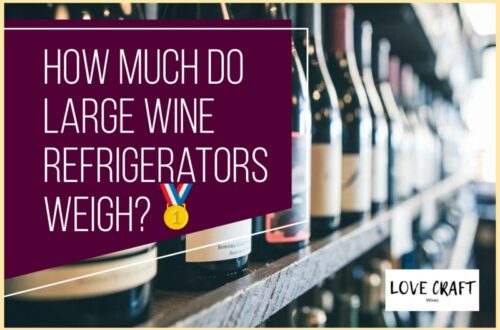Did you know that the temperature at which you store your red wine can greatly impact its taste and quality? In fact, according to a study by the Wine & Spirit Education Trust, improper storage can cause up to 80% of wine defects.
That’s why it’s crucial to understand the recommended temperature for storing red wine to ensure that you’re able to fully enjoy its rich flavors and aromas.
When it comes to red wine storage, there are several factors to consider, but temperature is perhaps the most important. The right temperature can help preserve the wine’s delicate balance of flavors and prevent it from spoiling prematurely.
In this article, we’ll dive into the ideal temperature range for storing red wine and provide some tips on how to maintain the quality of your wine collection. So, whether you’re a seasoned wine connoisseur or just starting to explore the world of red wine, read on to learn more about proper red wine storage.
Table of Contents
The Importance of Proper Storage for Red Wine
If you want to savor the full flavor and aroma of your favorite red wine, it’s crucial to store it correctly. Proper storage methods and wine preservation are essential to maintain the quality of your wine.
Whether you’re storing wine for a few weeks or a few years, it’s vital to ensure that it’s stored in ideal conditions.
The first thing to consider when storing red wine is the temperature. The temperature can make or break the flavor and aroma of your wine.
If the temperature is too high, it can cause the wine to age faster than it should, resulting in a loss of flavor and aroma. On the other hand, if the temperature is too low, the wine may not age at all, leading to a lack of complexity and character.
Understanding the impact of temperature on red wine is crucial to ensure that your wine is stored correctly.
Understanding the Impact of Temperature on Red Wine
Understanding how temperature affects your favorite bottle of red can make all the difference in how it tastes and ages over time. Wine preservation is a delicate process, and temperature plays a crucial role in ensuring that the wine maintains its quality.
Temperature fluctuations can cause chemical reactions to occur in the wine, which can lead to off-flavors and aromas. Therefore, it’s essential to understand how to store red wine correctly, especially if you’re a wine enthusiast or collector.
To understand the impact of temperature on red wine, consider the following:
-
Temperature affects the rate of wine aging. The higher the temperature, the faster the wine ages, and vice versa.
-
High temperatures can cause wine to expand, which can damage the cork and allow air to enter the bottle. This can lead to oxidation and spoilage.
-
Low temperatures can cause the wine to freeze, which can also damage the cork and affect the wine’s taste and texture.
With these factors in mind, it’s crucial to consider wine cellar design and temperature control when storing red wine.
In the next section, we’ll discuss the ideal temperature range for storing red wine to ensure that it maintains its quality and taste over time.
The Ideal Temperature Range for Storing Red Wine
Maintaining the perfect conditions for your favorite bottle of red can be a challenge, but finding the ideal range of coolness and warmth will help preserve its flavor and bouquet for future enjoyment.
Temperature control is crucial in wine preservation, as temperature fluctuations can damage the wine and alter its taste. Generally, red wine should be stored at a temperature between 55-65°F (13-18°C). This range ensures that the wine ages gracefully and doesn’t spoil prematurely.
It’s important to note that storing red wine at a temperature above 70°F (21°C) can accelerate the aging process and cause the wine to spoil. Similarly, storing it at a temperature below 45°F (7°C) can prevent the wine from aging and alter its taste. Therefore, it’s best to find a cool, dark place that maintains a consistent temperature within the recommended range.
Other factors to consider when storing red wine include humidity, light, and vibrations, which we’ll discuss in the next section.
Other Factors to Consider When Storing Red Wine
To ensure that your favorite bottle of red stays in its best condition, pay attention to factors like humidity, lighting conditions, and vibrations when storing it. These factors can affect the taste, aroma, and overall quality of your wine.
Here are some other factors to consider when storing red wine:
-
Humidity control: The ideal humidity level for storing wine is between 50% to 70%. High humidity can cause mold growth, while low humidity can dry out the cork and allow air into the bottle, leading to oxidation and spoilage. You can control humidity by storing your wine in a cool, dark place and using a humidifier or a damp cloth to maintain the right level of moisture.
-
Lighting conditions in storage: Light can also affect the quality of your wine, especially ultraviolet (UV) light. UV light can break down the organic compounds in wine, causing it to taste flat or stale. To prevent this, store your wine in a dark place or use UV-filtered glass or shades to block out light.
In addition to these factors, vibrations can also damage the delicate structure of wine. Vibrations can cause sediment to mix with the wine, making it cloudy or gritty. To prevent this, store your wine in a stable, vibration-free environment.
With these factors in mind, you can ensure that your red wine stays in optimal condition and delivers the best possible taste and aroma.
When it comes to maintaining the quality of your red wine, there are a few more tips to consider. These include storing wine bottles horizontally to keep the cork moist, avoiding temperature fluctuations, and not storing wine in the kitchen or near appliances that generate heat.
By following these tips and paying attention to the factors mentioned earlier, you can enjoy your favorite red wine in its best condition for years to come.
Tips for Maintaining the Quality of Your Red Wine
If you want your red wine to be at its best, there are a few simple tips you should follow.
First, make sure you’re serving it at the recommended temperature. Generally, red wines are best served at room temperature, which is around 60-68°F (15-20°C). However, this can vary depending on the type of red wine you have. For example, lighter red wines such as Pinot Noir or Beaujolais are best served slightly cooler, around 55°F (13°C), while full-bodied red wines such as Cabernet Sauvignon or Shiraz can be served slightly warmer, around 65°F (18°C).
Another important factor to consider when storing red wine is wine preservation techniques.
Once you’ve opened a bottle of red wine, it’s important to preserve it properly to maintain its quality. One way to do this is to use a vacuum pump to remove the air from the bottle, which will slow down the oxidation process. You can also use a wine preserver spray, which forms a protective layer over the wine. Another option is to transfer the wine to a smaller bottle or container, which will reduce the amount of air in contact with the wine.
By following these tips, you can ensure that your red wine stays fresh and delicious for longer.
Frequently Asked Questions
What is the best way to store red wine if you don’t have a wine cellar?
You don’t need a fancy wine cellar to properly store your red wine. Wine rack alternatives can be just as effective in keeping your bottles in optimal condition.
However, don’t underestimate the importance of temperature control. Even a few degrees can make a significant difference in the taste and quality of your wine.
Invest in a wine fridge or cooler to ensure your bottles are stored at a consistent temperature. Exaggeration aside, maintaining the right temperature is crucial for preserving the integrity of your wine and ultimately, your drinking experience.
Can I store red wine in the refrigerator?
Storing red wine in the refrigerator can be a quick and convenient option, but it comes with its own set of pros and cons. The main benefit of refrigerator storage is that it can help preserve the wine for a short period of time, especially if you’ve already opened the bottle.
However, the fluctuating temperatures in a fridge can negatively impact the wine’s quality over time. When wine is exposed to constant temperature changes, its flavor and aroma can deteriorate, which is why it’s not recommended for long-term storage.
Ultimately, if you’re looking to preserve the quality of your red wine, it’s best to invest in a proper wine cellar or storage solution that maintains a consistent temperature.
How long can you store red wine before it goes bad?
If you’re planning on storing your red wine for the long-term, it’s important to know how long it can be stored before it goes bad.
Generally, most red wines can be stored for a few years, but some can last up to a couple of decades if stored properly.
However, it’s important to keep an eye out for signs of spoilage such as a musty smell, a cloudy appearance, or a sour taste.
These are all indications that your red wine has gone bad and should be discarded.
To avoid spoilage, make sure to store your red wine in a cool, dark place with a consistent temperature and humidity level.
Does the type of bottle affect the storage of red wine?
You may have heard that the type of bottle you store your red wine in can affect its aging process. So, glass vs cork: which bottle type is best for storing red wine?
Well, the answer is: it depends. While most wine bottles are made of glass, some winemakers prefer to use cork for certain types of wines. The shape of the bottle can also play a role in the aging process, with some shapes being better suited for certain types of wine.
Ultimately, it’s important to consider the specific wine you’re storing and do some research on the best bottle type for that particular wine. But don’t forget about other important factors, like the temperature and humidity of your storage area, as these can also greatly impact the aging process of your red wine.
Does the location of the wine storage area affect the quality of the wine?
When it comes to wine storage, the location of your wine rack or cabinet placement is crucial in maintaining the quality of your red wine.
Ideally, you want to store your wine in a cool, dark, and humid place away from direct sunlight and heat sources.
Avoid placing your wine rack near windows or in areas exposed to fluctuating temperatures.
The ideal temperature range for storing red wine is between 55-65°F (12-18°C). Any higher than that can lead to premature aging and spoilage of the wine.
Additionally, make sure to keep your wine bottles horizontal to prevent the cork from drying out, which can cause air to enter the bottle and spoil the wine.
By following these simple guidelines, you can ensure that your red wine is stored in optimal conditions and maintain its quality for years to come.
Conclusion
Congratulations, you now know the recommended temperature for storing your red wine! Remember, proper storage is crucial in maintaining the quality of your wine. Temperature plays a significant role in the aging process, and it’s essential to keep it at the ideal range to prevent spoilage.
As the saying goes, "Rome wasn’t built in a day," and the same goes for wine. It takes time and patience to achieve the full potential of your red wine.
By storing it at the recommended temperature and following the tips we provided, you’ll be able to savor every sip and enjoy the full spectrum of flavors and aromas.
In conclusion, remember to keep your red wine stored in a cool, dark place with a consistent temperature of around 55°F. By doing so, you’ll be able to enjoy your wine to the fullest, and who knows, maybe one day, you’ll have a collection of perfectly aged red wines that you can be proud of.
Cheers to that!





